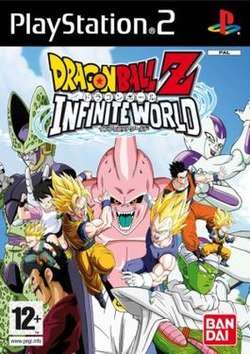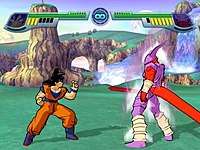Dragon Ball Z: Infinite World
Dragon Ball Z: Infinite World (ドラゴンボールZ インフィニットワールド, Doragon Bōru Zetto Infinitto Wārudo) is a fighting video game for the PlayStation 2 based on the anime and manga series Dragon Ball, and is an expansion title of the 2004 video game Dragon Ball Z: Budokai 3. The game was developed by Dimps and published in North America by Atari and in Europe and Japan by Namco Bandai Games under the Bandai label. It was released in North America on November 4, 2008,[1] in Japan on December 4, and in Europe the following day.[2]
| Dragon Ball Z: Infinite World | |
|---|---|
 | |
| Developer(s) | Dimps |
| Publisher(s) |
|
| Series | Dragon Ball |
| Engine | Budokai 3 |
| Platform(s) | PlayStation 2 |
| Release | |
| Genre(s) | Fighting |
| Mode(s) | Single-player, multiplayer |
The game is a fighting game, the player pits their character against other characters controlled by the in game AI or by another player, which depends on the mode that the player or players are in. The Dragon Mission game mode features other gameplay elements, making the gameplay less linear. Within a week of the game's initial release in Japan, it sold 76,452 units. The game received generally mixed reviews, with some of video games publications commenting on its frustrating gameplay and very little differences to older Dragon Ball Z games. However, the game has become a cult classic within the franchise, and is often cited as an improvement over its predecessor Budokai 3. It is the last Dragon Ball game to be released in North America by Atari, due to losing the rights to Bandai.
Gameplay

The game's mechanics are essentially the same as the Budokai games, with some elements carried over from Burst Limit. Players take control of and battle various characters from the Dragon Ball franchise. 42 characters are playable, in comparison with Budokai 3, which had thirty-eight characters in its roster.
The story mode, called Dragon Mission, is displayed as a map with various objective missions icons that retell some of the battles within Dragon Ball Z and Dragon Ball GT. Players take control of their icon, a Goku avatar, by walking or running to an available mission icon. These missions range from standard and timed endurance battles. Other missions include mini games such as on-foot searches, races to reach a destination or find an item, timed button sequence responders and first person shooters.[3]
Skill capsules are carried over from the Budokai games. They allow players to customize characters with a variety of special techniques and attributes. The capsules can be bought with Zeni, and the more of the same capsule a player buys, the stronger their effects become. This differs from the Budokai games, where skills had to be placed multiple times on a character for them to become stronger.[4]
A mode called "Fighter's Road" becomes available after certain goals are met. Players participate in a series of battles on four of the maps from the Dragon Mission mode. Like Dragon Mission, players are rewarded a certain amount of Zeni after every victory. They are also rewarded more Zeni according to how many battles they've won when they exit.[5]
Development
The game was first announced in August 2008 by Atari's French website. The announcement stated that the game was in development by Dimps and would retain many of the qualities found in the Budokai series, yet they would include new innovations such as the Dragon Mission mode and a simplified combat system from Burst Limit. It was also promised that the game's roster would include up to forty playable characters, not including transformations and was given a European release date of sometime in December of that year. Included with the announcement were several screenshots which revealed gameplay of the combat system and four of the mini-games from both the Saiyan and Android sagas.[6] This was followed by an announcement posted on Atari's North American page revealing that they would retain the Infinite World title and a release date sometime in November.[7] Around the same time, V Jump announced the game would be released in Japan and that the game would also utilize the Infinite World title.[8] In September, more information was released stating that the capsule system would be brought back and the audio would include the both English and Japanese voice talent.[9] In October, Famitsu posted more screenshots revealing more mini-games within the Frieza and Cell sagas.[10] On October 15, Atari released a press statement announcing that the game was completed.[1][11] A few days later the game was unveiled at the Tokyo Game Show.[12][13]
According to producer Riyo Mito, the game's title Infinite World implies the immense gameplay of the epic Dragon Ball universe within the scope of the game's Dragon Mission mode, he also said that this is the fourth installment of the "Budokai" series. The game was specifically chosen for the PlayStation 2 to target fans that did not have access to the PlayStation 3 and Xbox 360 consoles to play the previous title, Burst Limit, at the time.[14]
Music
Composer Kenji Yamamoto returns to provide music for the game along with Kanon Yamamoto, with both credited as Kenz and Canon respectively.[15] There are twenty-two pieces created exclusively for the game, with the rest carried over from the previous three Budokai games. The game's theme songs "Hikari no Sasu Mirai e!" and "Dragon Ball Party" were written by Yuriko Mori and performed by Hironobu Kageyama.[16] However, the game's North American packaging only features Kageyama as a contributor, and the game's instruction manual does not list any music credits,[17] causing people in the gaming community, not familiar with the material, to believe that Kageyama was the game's composer. Some game critics have gone on to record in their reviews citing the music as the superior part of the game.[18][19][20] The new music was released as Dragon Ball Z: Infinite World Original Soundtrack by Lantis on January 7, 2009,[21] while the theme songs were released as a single by King Records on Christmas Day 2008.[22]
Reception
The game went on to only sell 200,000 copies in Japan and 80,000 copies in the United States as of August 2010. However, Infinite World went on to become Japan's second top-selling game in 2008, selling 76,452 units the first week in the country right behind Professor Layton and the Unwound Future.[23] It was reported that the game, along with Backyard Baseball and Alone in the Dark, helped Atari out of their financial slump with a net 44.5 percent increase.[24]
| Reception | ||||||||||||||||||||||||
|---|---|---|---|---|---|---|---|---|---|---|---|---|---|---|---|---|---|---|---|---|---|---|---|---|
| ||||||||||||||||||||||||
During its initial release, Infinite World received mixed reviews. Many felt the game was identical to Budokai 3, while others thought the game's story mode and mini games were too daunting, and that the game was geared more towards hardcore fans instead of casual gamers. It earned aggregated scores of 48/100 on Metacritic, a score of 50.80% on GameRankings, and IGN gave the game a 3.5; a score lower than that of the critically panned Dragon Ball Z: Ultimate Battle 22. However, the game has been accepted more positively by the fans throughout the years and received a cult following, with many reviewers praising the game's improved visuals and gameplay along with the inclusion of extra characters missing from the previous Budokai games. Ironically the back of the box says "The Best of the Budokai Series".
Notes
- Marketed under the Bandai logo.
References
- Walker, Matthew (October 15, 2008). "Dragon Ball Z: Infinite World Goes Gold". GameSpy. Retrieved May 24, 2009.
- "Dragon Ball Z: Infinite World Release Information for PlayStation 2". GameFAQs. Retrieved June 16, 2014.
- "Dragon Mission". Dragon Ball Z: Infinite World. Atari. 2008. p. 4.
- "Warrior's Room". Dragon Ball Z: Infinite World. Atari. 2008. p. 7.
- "Fighter's Road". Dragon Ball Z: Infinite World. Atari. 2008. p. 10.
- "Actualités 'DRAGON BALL Z: INFINITE WORLD' CONCENTRE ET DéCHAîNE LE MEILLEUR DE L'UNIVERS DRAGON BALL Z SUR PLAYSTATION 2" (in French). Atari. August 20, 2008. Archived from the original on April 18, 2009. Retrieved May 20, 2009.
- "News Release 'Dragon Ball Z(R): Infinite World' Brings Best of Dragon Ball Z Universe to Playstation(R)2 Computer Entertainment System". Atari. Retrieved May 20, 2009.
- "Dragon Ball Z: Infinite World PS2 よみがえるZの采譜! 最高迢!!!!". V Jump (in Japanese). Shueisha: 48 & 49. August 2008.
- Glasser, AJ (September 12, 2008). "Hands On: Dragon Ball Z: Infinite World – Gah! Too Many Colons!". Kotaku. Retrieved May 20, 2009.
- "『ドラゴンボールZ インフィニットワールド』あの名シーンを追体験せよ" (in Japanese). Famitsu. October 10, 2008. Retrieved May 20, 2009.
- IGN staff (October 15, 2008). "Dragon Ball Z: Infinite World Goes Gold". IGN. Retrieved June 16, 2014.
- Fitch, Andrew (October 17, 2008). "Dragon Ball Z: Infinite World (Preview)". 1UP.com. Archived from the original on October 7, 2012. Retrieved June 16, 2014.
- Ramsay, Randolph (October 10, 2008). "TGS 2008: Drums, Gundams, and Ninjas at Namco Bandai". GameSpot. Retrieved June 15, 2014.
- GamesRadar US (October 21, 2008). "Why is Dragon Ball Z: Infinite World on PS2? We grill DBZ producer Riyo Mito on the latest Saiyin scrapper". GamesRadar. Retrieved June 2, 2009.
- "59's Laboratory, Inc., About Us" (Flash) (in English and Japanese). 59's Laboratory. Retrieved November 11, 2009.
- "光のさす未来へ!/Dragon Ball Party". Yahoo Music jp. Archived from the original on July 11, 2012. Retrieved June 2, 2009.
- "Credits". Dragon Ball Z: Infinite World. Atari. 2008. pp. 11 & 12.
- Nimer, Jason. "Dragon Ball Z: Infinite World - Review". The Gamers Temple. Retrieved February 8, 2009.
- Kim, Alan (November 24, 2008). "Dragon Ball Z: Infinite World Review". Game Radar. Retrieved February 8, 2009.
- Jesús Bella Ceacero (December 4, 2008). "Dragon Ball Z: Infinite World, Dragon Ball Z y sus luchadores exhiben en combate la última onda vital de PlayStation 2." (in Spanish). 3DJuegos. Retrieved May 24, 2009.
- "2009.01.07 Release" (in Japanese). Lantis. Retrieved February 8, 2009.
- "2008.12.25 Release". Lantis. Retrieved February 8, 2009.
- Tanaka, John (December 12, 2008). "Layton and DSi Top Japanese Charts". IGN. Retrieved June 16, 2014.
- Bailey, Kat (November 17, 2008). "Atari Posts 45 percent First-Half Revenue Increase Publisher attributes success to Alone in the Dark and Dragon Ball Z." 1UP.com. Archived from the original on November 4, 2012. Retrieved June 16, 2014.
- "Dragon Ball Z: Infinite World for PlayStation 2". GameRankings. Retrieved May 30, 2009.
- "Dragon Ball Z: Infinite World for PlayStation 2 Reviews". Metacritic. Retrieved June 16, 2014.
- Noble, McKinley (November 4, 2008). "Dragon Ball Z: Infinite World". GamePro. Archived from the original on 2008-12-06. Retrieved December 4, 2008.
- Tan, Nick (December 5, 2008). "Dragon Ball Z: Infinite World Review". Game Revolution. Retrieved June 17, 2014.
- Perez, Anthony (December 9, 2008). "Dragon Ball Z: Infinite World Review". GameSpot. Retrieved June 16, 2014.
- Kim, Alan (November 24, 2008). "Dragon Ball Z: Infinite World review". GamesRadar. Retrieved June 17, 2014.
- Grabowski, Dakota (November 23, 2008). "Dragon Ball Z: Infinite World - PS2 - Review". GameZone. Archived from the original on December 17, 2008. Retrieved June 16, 2014.
- Miller, Greg (November 18, 2008). "Dragon Ball Z: Infinite World Review". IGN. Retrieved June 16, 2014.
External links
- Official Japanese Website (in Japanese)